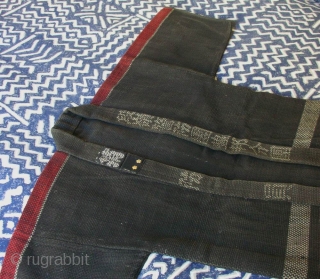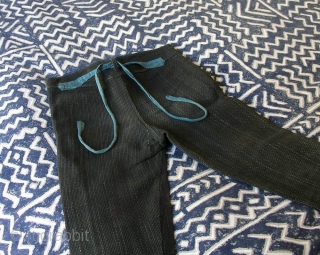Back
Firefighter set, Japan, early Showa (circa 1930), cm 88x130 (jacket) – lenght cm 97 (pants). In old Japan, where wood architecture was predominant, fires occurred frequently. Firefighting was an extremely hazardous occupation and one of the most honourable activities. Therefore, in the early Edo period, only samurai were employed for the job. From mid-18th century onwards, organized groups of townsmen firefighters took control of activities but the commander almost invariably remained a samurai. With Meiji restoration samurai lost their status and honours, and the firefighters became an army-like body with uniforms and ranks. The service dresses had a typical multilayer structure of cotton cloths and heavy ‘sashiko’ stiching, and when soaked with water they provided a sort of protection to the fire. This actual set of jacket and pants can be dated to circa 1930, as the sashiko stitchings were machine-made, and possibly belonged to an official as the collar rank badge (see detail picture) would suggest. ‘Tsutsugaki’ technique dyed cotton cloths, in used, good condition with still the original light blue belt for the pants.
price:
SOLD
- Home
- Antique Rugs by Region
- Category
- Profiles
- Post Items Free
- Albums
- Benaki Museum of Islamic Art
- Budapest: Ottoman Carpets
- Gulbenkian Museum
- Islamic Carpets. Brooklyn
- Islamic Textiles. Brooklyn
- Konya Museum: Rugs
- MKG, Hamburg
- MMA: Caucasian Carpets
- MMA: Mamluk Carpets
- MMA: Mughal Indian Carpets
- MMA: Ottoman Carpets
- MMA: Safavid Persian Carpets
- MMA: Turkmen Rugs
- McCoy Jones Kilims
- Ottoman textiles. Met
- Philadelphia Museum
- Rugs and Carpets: Berlin
- Seljuqs at the Met
- TIEM, Istanbul: Carpets
- V&A: Classical Carpets
- Vakiflar Carpets: Istanbul
- Baluch Rugs: Indianapolis
- Gallery Exhibitions
- Jaf an Exhibition
- Alberto Levi Gallery
- Andean Textile
- Christie's London: 2016
- Francesca Galloway
- HALI at 40
- ICOC Washington, DC 2018
- Jajims of the Shahsavan
- London Islamic Week April, 2018
- Mongolian Felts
- Navajo Rugs: JB Moore
- Persian Piled Weavings
- SF Tribal & Textile Art Show 2020
- SF Tribal 2019
- Sotheby's: C. Alexander
- Turkish Prayer Rugs
- Turkmen Main Carpets ICOC 2007











